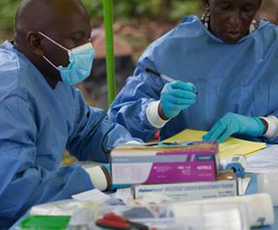
- Country Health Emergency Preparedness and the International Health Regulations »
- Emergency Operations »
- Health Emergency Information and Risk Assessments »
- Infectious Hazards Management »
In the African Region, more than 100 major public health emergencies are reported annually, affecting millions of people. To meet the immediate health needs of crisis-affected populations while simultaneously addressing the underlying causes of their vulnerability, WHO must be part of a broader change in the way the international community prevents, prepares for and responds to public health emergencies.
The WHO Health Emergencies Programme, approved by Member States at the sixty-ninth World Health Assembly in May 2016, streamlines the WHO emergency response efforts via the formation of a single programme with one workforce, one budget, one line of accountability, one set of processes and systems and one set of benchmarks. The programme brings together the expertise and resources of the previously separate programmes on outbreaks and humanitarian crises. This is an important step towards becoming an emergency operations agency to complement the WHO technical and normative roles. The new programme is designed to bring speed and predictability to the WHO emergency work by using a single-incident management system, an all-hazards approach, promoting collective action and encompassing all stages of the emergency cycle from preparedness to recovery.
Functions & structure
WHO is committed to saving lives and reducing suffering during times of crisis – whether caused by conflict, disease outbreaks or disasters. The WHO Health Emergencies Programme works with countries and partners to prepare for, prevent, respond to and recover from all hazards that create health emergencies, including disasters (natural or human-made), disease outbreaks and conflicts. The programme leads and coordinates the international health response to contain disease outbreaks and provide effective relief and recovery to affected people. We acknowledge that health must be seen from a wider perspective and are committed to building and applying a One Health Approach in all areas of our work on outbreaks.
The programme has a common structure across the organization (in country offices, regional offices and headquarters), reflecting WHO’s major functions and responsibilities in health emergency risk assessment and management, delivered through five technical and operational programme areas:
- Country Health Emergency Preparedness and the International Health Regulations
- Emergency Operations
- Health Emergency Information and Risk Assessments
- Infectious Hazards Management
- Management and Administration
An Independent Oversight and Advisory Committee was established in March 2016 to monitor the development and performance of the programme, guide its activities and report on its progress.
Partners
No organization can act alone in emergencies. The WHO Health Emergencies Programme works with its partners to protect and save people’s lives in all health emergencies. During a crisis, WHO works with the local ministries of health and partners to identify where health needs are greatest and to coordinate the efforts of partner organizations to ensure that these areas are covered by both medical supplies and personnel. WHO regularly collaborates with partner networks to leverage and coordinate the expertise of hundreds of partner agencies, including the:
- Global Health Cluster – More than 300 partners responding in 24 crisis-affected countries.
- Emergency Medical Teams – More than 60 teams from 25 countries classified by WHO to provide clinical care in the wake of emergencies, with the number expected to rise to 200 soon.
- Global Outbreak Alert and Response Network (GOARN) – Since 2000, approximately 2,500 health personnel in response to over 130 public health emergencies in 80 countries.
- Standby partners – In 2015, WHO Standby Partners deployed 207 months of personnel support to 18 countries.
- Inter-Agency Standing Committee (IASC) – WHO is an active member of IASC, the primary mechanism for inter-agency coordination relating to humanitarian assistance in response to complex and major emergencies under the leadership of the Emergency Relief Coordinator.
Funding
Adequate financing is a prerequisite for the success of all aspects of the WHO Health Emergencies Programme, including its work to support the strengthening of member state preparedness. The financial viability and sustainability of the WHO Health Emergencies Programme requires a combination of core financing for the WHO standing emergency risk management capacity and normative work, a contingency fund for rapidly initiating and enabling new emergency response operations and an ongoing appeal and pledging process to support major ongoing operations, particularly protracted crises, guided by humanitarian response plans.
Further information
For further information, please visit WHO in emergencies.


